Leadership and Management in Kensington Supermarket: Unit 4 Report
VerifiedAdded on 2023/01/07
|17
|5278
|52
Report
AI Summary
This report provides a comprehensive analysis of leadership and management practices at Kensington Supermarket, a UK-based grocery store. It begins with an overview of the company's management structure and defines the roles of leaders and managers, differentiating their functions in various situations, such as conflict resolution and managing employee resistance to change. The report explores different leadership approaches, including situational leadership, systems leadership, and contingency leadership, evaluating their strengths and weaknesses. It then critically examines contemporary theories like Management by Objectives and Behavioral Theories, assessing their application in the context of the supermarket. The report also introduces key operational functions, operational management approaches, and factors affecting the business environment. It concludes by evaluating how to improve operational efficiency and effectively meet organizational objectives through appropriate leadership and management strategies, including the application of OM theory and factors that impact on huge business environment.
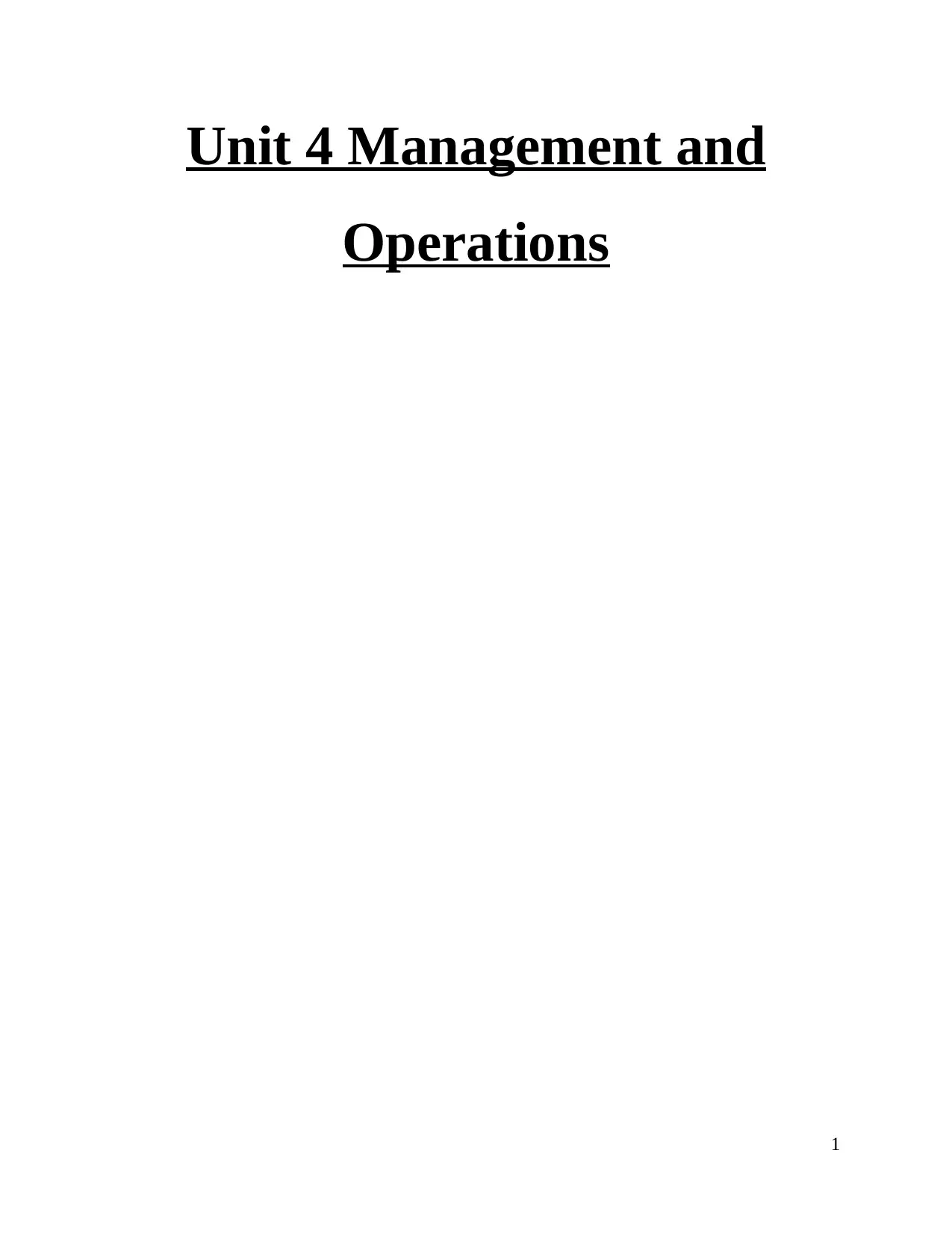
Unit 4 Management and
Operations
1
Operations
1
Paraphrase This Document
Need a fresh take? Get an instant paraphrase of this document with our AI Paraphraser
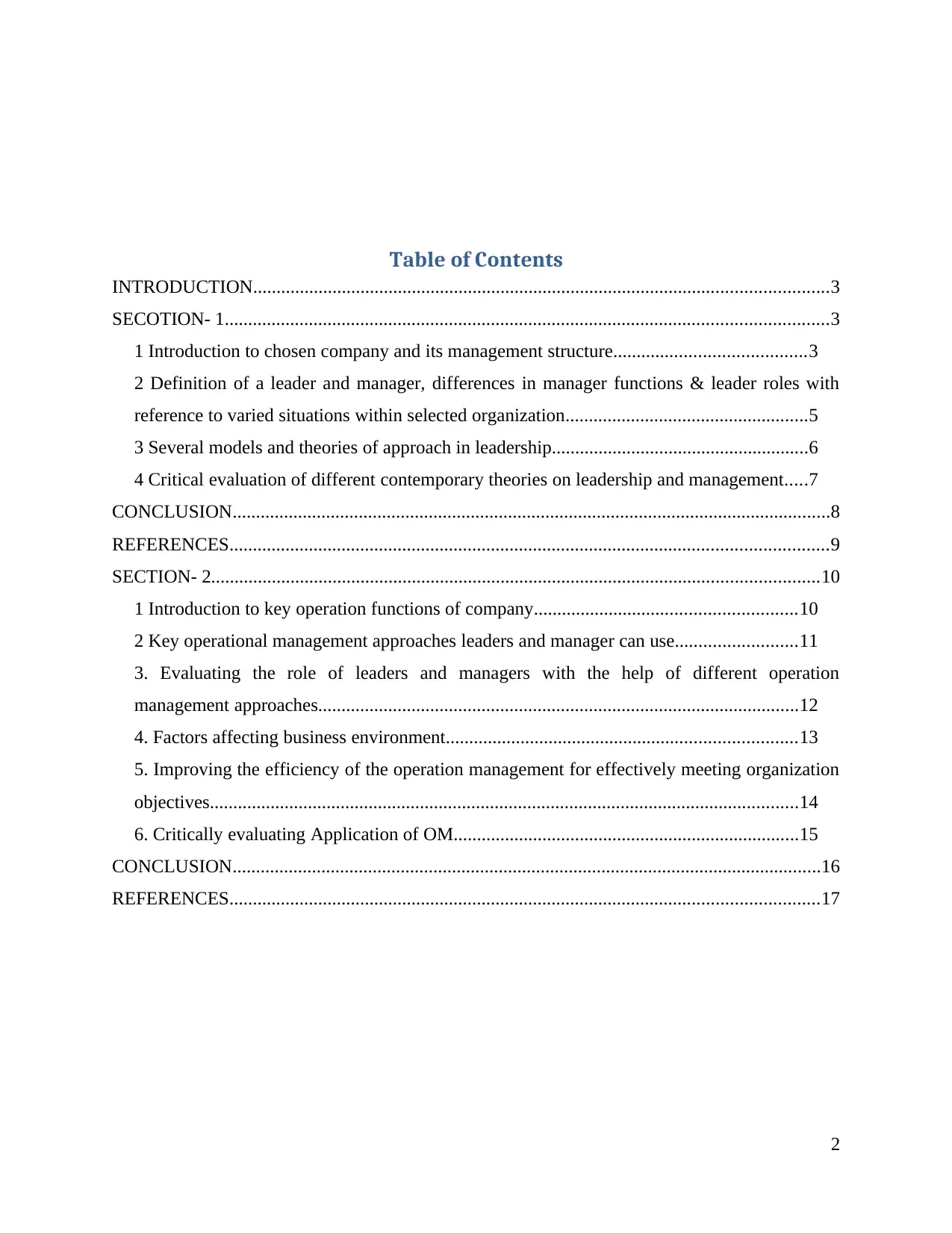
Table of Contents
INTRODUCTION...........................................................................................................................3
SECOTION- 1.................................................................................................................................3
1 Introduction to chosen company and its management structure.........................................3
2 Definition of a leader and manager, differences in manager functions & leader roles with
reference to varied situations within selected organization....................................................5
3 Several models and theories of approach in leadership.......................................................6
4 Critical evaluation of different contemporary theories on leadership and management.....7
CONCLUSION................................................................................................................................8
REFERENCES................................................................................................................................9
SECTION- 2..................................................................................................................................10
1 Introduction to key operation functions of company........................................................10
2 Key operational management approaches leaders and manager can use..........................11
3. Evaluating the role of leaders and managers with the help of different operation
management approaches.......................................................................................................12
4. Factors affecting business environment...........................................................................13
5. Improving the efficiency of the operation management for effectively meeting organization
objectives..............................................................................................................................14
6. Critically evaluating Application of OM..........................................................................15
CONCLUSION..............................................................................................................................16
REFERENCES..............................................................................................................................17
2
INTRODUCTION...........................................................................................................................3
SECOTION- 1.................................................................................................................................3
1 Introduction to chosen company and its management structure.........................................3
2 Definition of a leader and manager, differences in manager functions & leader roles with
reference to varied situations within selected organization....................................................5
3 Several models and theories of approach in leadership.......................................................6
4 Critical evaluation of different contemporary theories on leadership and management.....7
CONCLUSION................................................................................................................................8
REFERENCES................................................................................................................................9
SECTION- 2..................................................................................................................................10
1 Introduction to key operation functions of company........................................................10
2 Key operational management approaches leaders and manager can use..........................11
3. Evaluating the role of leaders and managers with the help of different operation
management approaches.......................................................................................................12
4. Factors affecting business environment...........................................................................13
5. Improving the efficiency of the operation management for effectively meeting organization
objectives..............................................................................................................................14
6. Critically evaluating Application of OM..........................................................................15
CONCLUSION..............................................................................................................................16
REFERENCES..............................................................................................................................17
2
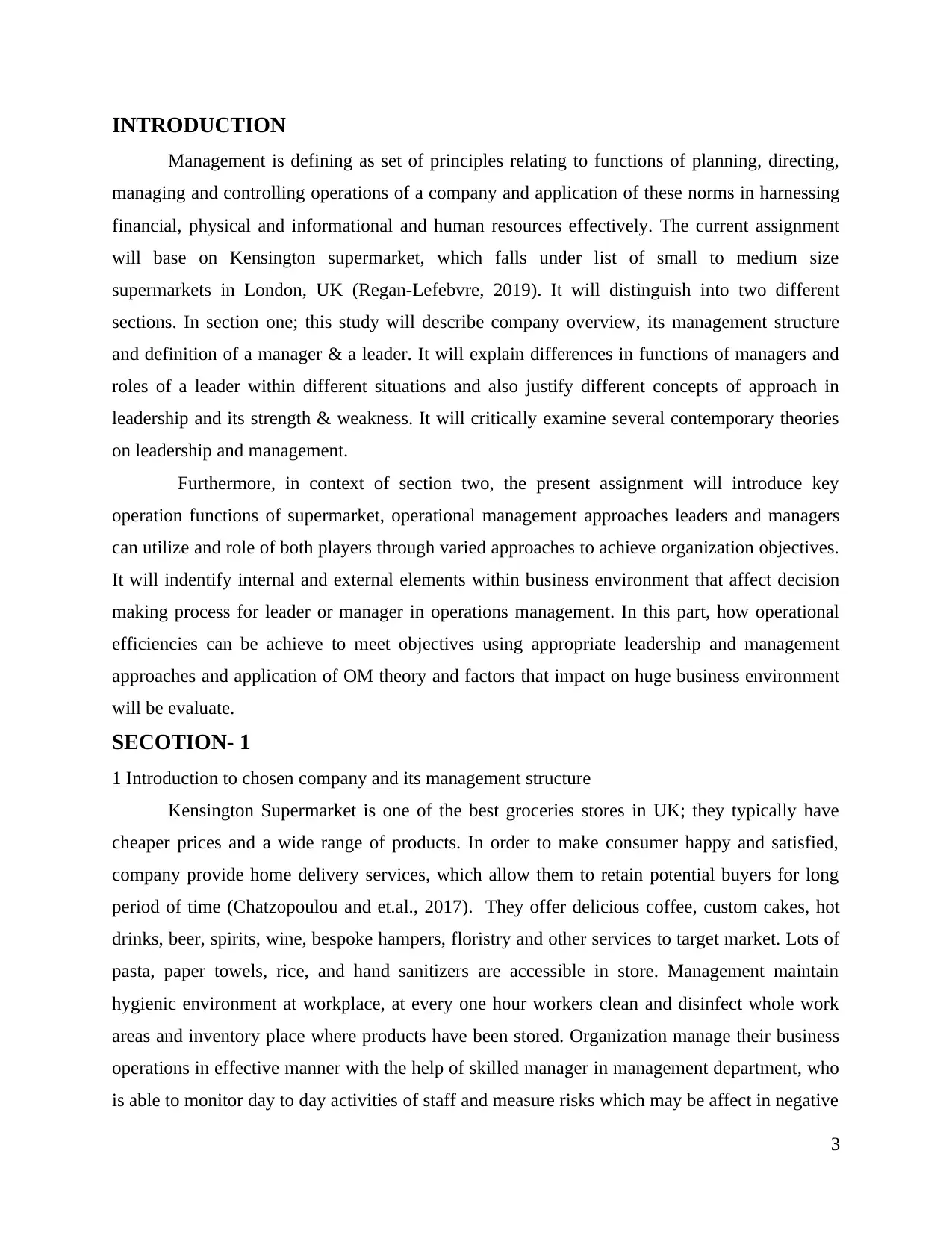
INTRODUCTION
Management is defining as set of principles relating to functions of planning, directing,
managing and controlling operations of a company and application of these norms in harnessing
financial, physical and informational and human resources effectively. The current assignment
will base on Kensington supermarket, which falls under list of small to medium size
supermarkets in London, UK (Regan-Lefebvre, 2019). It will distinguish into two different
sections. In section one; this study will describe company overview, its management structure
and definition of a manager & a leader. It will explain differences in functions of managers and
roles of a leader within different situations and also justify different concepts of approach in
leadership and its strength & weakness. It will critically examine several contemporary theories
on leadership and management.
Furthermore, in context of section two, the present assignment will introduce key
operation functions of supermarket, operational management approaches leaders and managers
can utilize and role of both players through varied approaches to achieve organization objectives.
It will indentify internal and external elements within business environment that affect decision
making process for leader or manager in operations management. In this part, how operational
efficiencies can be achieve to meet objectives using appropriate leadership and management
approaches and application of OM theory and factors that impact on huge business environment
will be evaluate.
SECOTION- 1
1 Introduction to chosen company and its management structure
Kensington Supermarket is one of the best groceries stores in UK; they typically have
cheaper prices and a wide range of products. In order to make consumer happy and satisfied,
company provide home delivery services, which allow them to retain potential buyers for long
period of time (Chatzopoulou and et.al., 2017). They offer delicious coffee, custom cakes, hot
drinks, beer, spirits, wine, bespoke hampers, floristry and other services to target market. Lots of
pasta, paper towels, rice, and hand sanitizers are accessible in store. Management maintain
hygienic environment at workplace, at every one hour workers clean and disinfect whole work
areas and inventory place where products have been stored. Organization manage their business
operations in effective manner with the help of skilled manager in management department, who
is able to monitor day to day activities of staff and measure risks which may be affect in negative
3
Management is defining as set of principles relating to functions of planning, directing,
managing and controlling operations of a company and application of these norms in harnessing
financial, physical and informational and human resources effectively. The current assignment
will base on Kensington supermarket, which falls under list of small to medium size
supermarkets in London, UK (Regan-Lefebvre, 2019). It will distinguish into two different
sections. In section one; this study will describe company overview, its management structure
and definition of a manager & a leader. It will explain differences in functions of managers and
roles of a leader within different situations and also justify different concepts of approach in
leadership and its strength & weakness. It will critically examine several contemporary theories
on leadership and management.
Furthermore, in context of section two, the present assignment will introduce key
operation functions of supermarket, operational management approaches leaders and managers
can utilize and role of both players through varied approaches to achieve organization objectives.
It will indentify internal and external elements within business environment that affect decision
making process for leader or manager in operations management. In this part, how operational
efficiencies can be achieve to meet objectives using appropriate leadership and management
approaches and application of OM theory and factors that impact on huge business environment
will be evaluate.
SECOTION- 1
1 Introduction to chosen company and its management structure
Kensington Supermarket is one of the best groceries stores in UK; they typically have
cheaper prices and a wide range of products. In order to make consumer happy and satisfied,
company provide home delivery services, which allow them to retain potential buyers for long
period of time (Chatzopoulou and et.al., 2017). They offer delicious coffee, custom cakes, hot
drinks, beer, spirits, wine, bespoke hampers, floristry and other services to target market. Lots of
pasta, paper towels, rice, and hand sanitizers are accessible in store. Management maintain
hygienic environment at workplace, at every one hour workers clean and disinfect whole work
areas and inventory place where products have been stored. Organization manage their business
operations in effective manner with the help of skilled manager in management department, who
is able to monitor day to day activities of staff and measure risks which may be affect in negative
3
⊘ This is a preview!⊘
Do you want full access?
Subscribe today to unlock all pages.

Trusted by 1+ million students worldwide
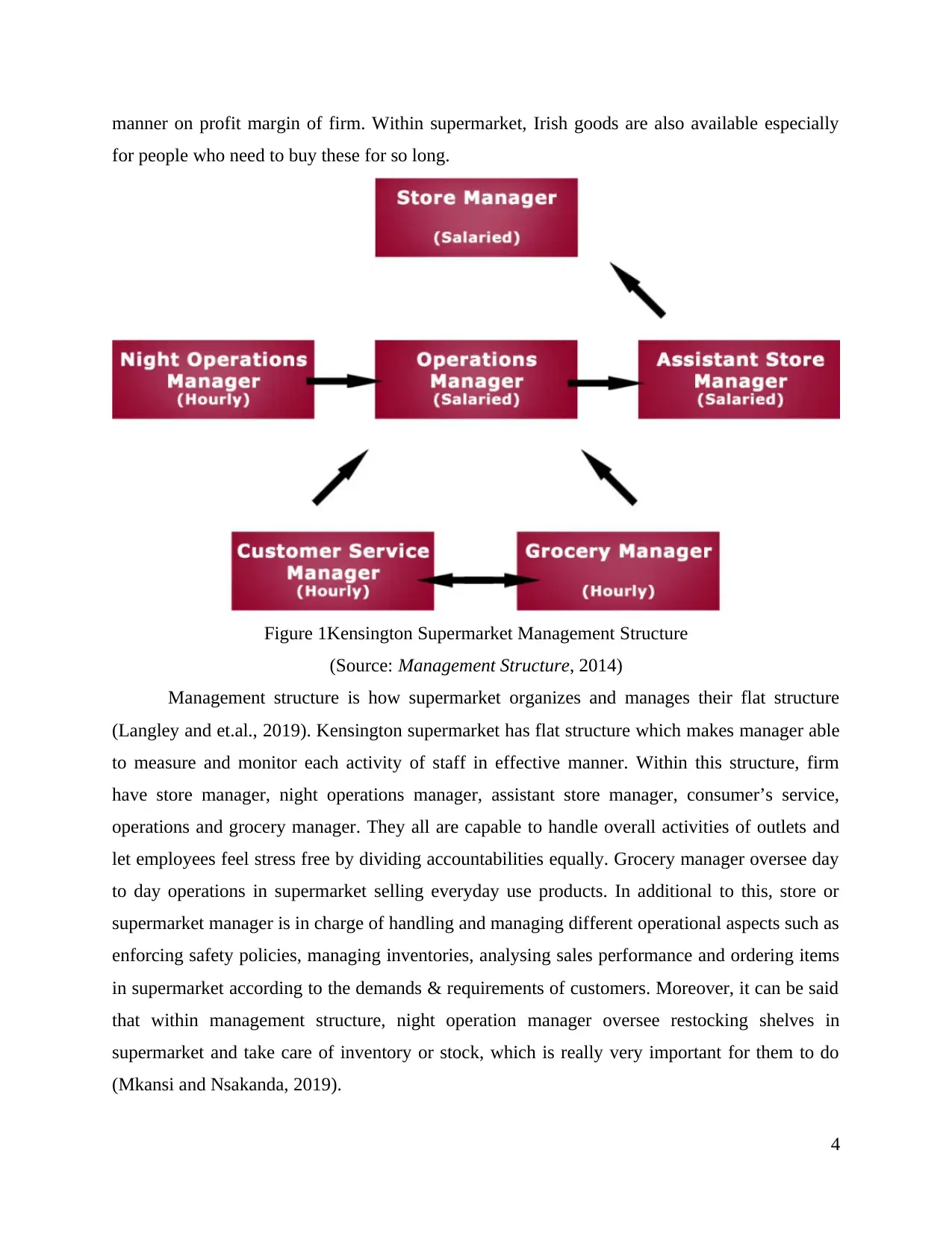
manner on profit margin of firm. Within supermarket, Irish goods are also available especially
for people who need to buy these for so long.
Figure 1Kensington Supermarket Management Structure
(Source: Management Structure, 2014)
Management structure is how supermarket organizes and manages their flat structure
(Langley and et.al., 2019). Kensington supermarket has flat structure which makes manager able
to measure and monitor each activity of staff in effective manner. Within this structure, firm
have store manager, night operations manager, assistant store manager, consumer’s service,
operations and grocery manager. They all are capable to handle overall activities of outlets and
let employees feel stress free by dividing accountabilities equally. Grocery manager oversee day
to day operations in supermarket selling everyday use products. In additional to this, store or
supermarket manager is in charge of handling and managing different operational aspects such as
enforcing safety policies, managing inventories, analysing sales performance and ordering items
in supermarket according to the demands & requirements of customers. Moreover, it can be said
that within management structure, night operation manager oversee restocking shelves in
supermarket and take care of inventory or stock, which is really very important for them to do
(Mkansi and Nsakanda, 2019).
4
for people who need to buy these for so long.
Figure 1Kensington Supermarket Management Structure
(Source: Management Structure, 2014)
Management structure is how supermarket organizes and manages their flat structure
(Langley and et.al., 2019). Kensington supermarket has flat structure which makes manager able
to measure and monitor each activity of staff in effective manner. Within this structure, firm
have store manager, night operations manager, assistant store manager, consumer’s service,
operations and grocery manager. They all are capable to handle overall activities of outlets and
let employees feel stress free by dividing accountabilities equally. Grocery manager oversee day
to day operations in supermarket selling everyday use products. In additional to this, store or
supermarket manager is in charge of handling and managing different operational aspects such as
enforcing safety policies, managing inventories, analysing sales performance and ordering items
in supermarket according to the demands & requirements of customers. Moreover, it can be said
that within management structure, night operation manager oversee restocking shelves in
supermarket and take care of inventory or stock, which is really very important for them to do
(Mkansi and Nsakanda, 2019).
4
Paraphrase This Document
Need a fresh take? Get an instant paraphrase of this document with our AI Paraphraser
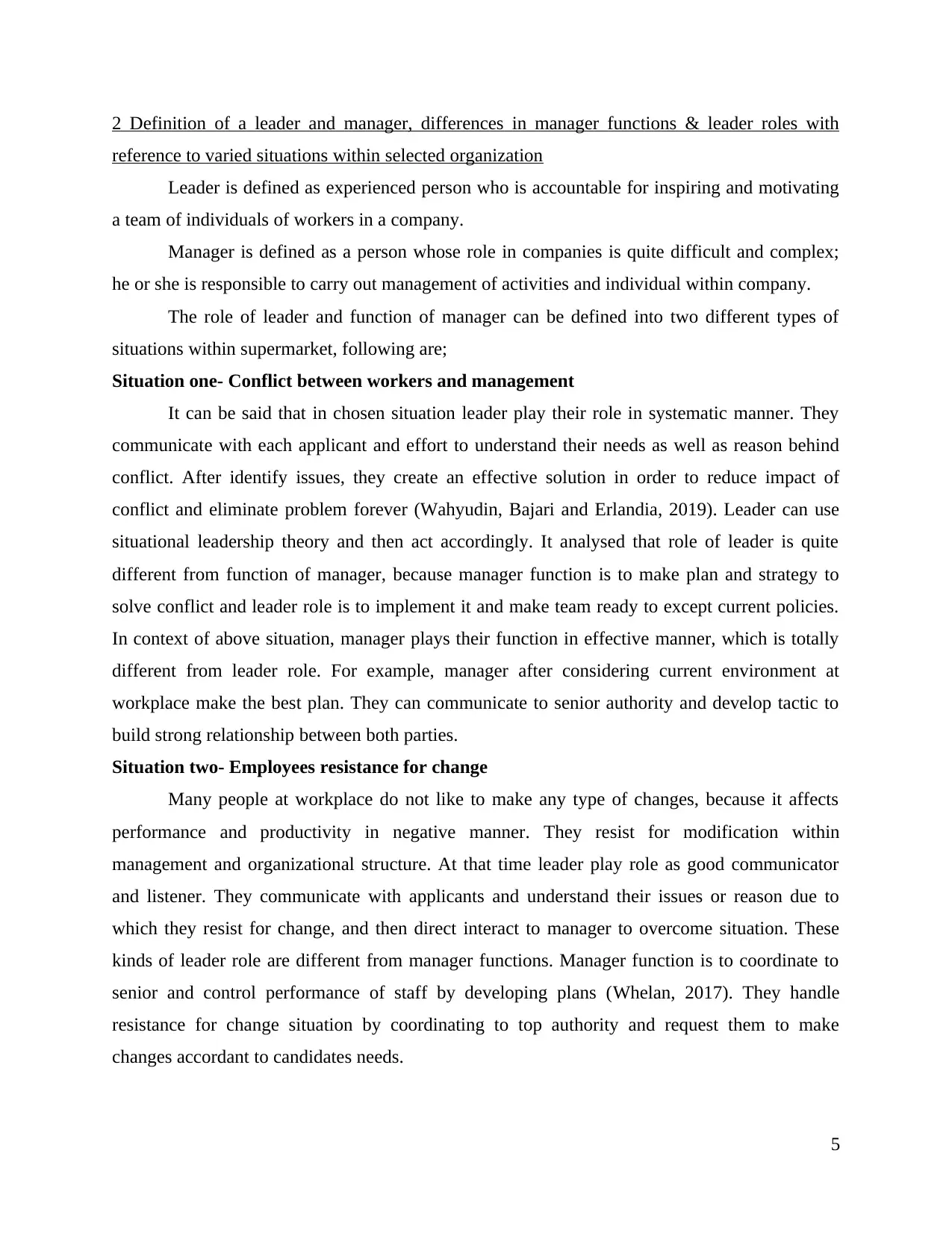
2 Definition of a leader and manager, differences in manager functions & leader roles with
reference to varied situations within selected organization
Leader is defined as experienced person who is accountable for inspiring and motivating
a team of individuals of workers in a company.
Manager is defined as a person whose role in companies is quite difficult and complex;
he or she is responsible to carry out management of activities and individual within company.
The role of leader and function of manager can be defined into two different types of
situations within supermarket, following are;
Situation one- Conflict between workers and management
It can be said that in chosen situation leader play their role in systematic manner. They
communicate with each applicant and effort to understand their needs as well as reason behind
conflict. After identify issues, they create an effective solution in order to reduce impact of
conflict and eliminate problem forever (Wahyudin, Bajari and Erlandia, 2019). Leader can use
situational leadership theory and then act accordingly. It analysed that role of leader is quite
different from function of manager, because manager function is to make plan and strategy to
solve conflict and leader role is to implement it and make team ready to except current policies.
In context of above situation, manager plays their function in effective manner, which is totally
different from leader role. For example, manager after considering current environment at
workplace make the best plan. They can communicate to senior authority and develop tactic to
build strong relationship between both parties.
Situation two- Employees resistance for change
Many people at workplace do not like to make any type of changes, because it affects
performance and productivity in negative manner. They resist for modification within
management and organizational structure. At that time leader play role as good communicator
and listener. They communicate with applicants and understand their issues or reason due to
which they resist for change, and then direct interact to manager to overcome situation. These
kinds of leader role are different from manager functions. Manager function is to coordinate to
senior and control performance of staff by developing plans (Whelan, 2017). They handle
resistance for change situation by coordinating to top authority and request them to make
changes accordant to candidates needs.
5
reference to varied situations within selected organization
Leader is defined as experienced person who is accountable for inspiring and motivating
a team of individuals of workers in a company.
Manager is defined as a person whose role in companies is quite difficult and complex;
he or she is responsible to carry out management of activities and individual within company.
The role of leader and function of manager can be defined into two different types of
situations within supermarket, following are;
Situation one- Conflict between workers and management
It can be said that in chosen situation leader play their role in systematic manner. They
communicate with each applicant and effort to understand their needs as well as reason behind
conflict. After identify issues, they create an effective solution in order to reduce impact of
conflict and eliminate problem forever (Wahyudin, Bajari and Erlandia, 2019). Leader can use
situational leadership theory and then act accordingly. It analysed that role of leader is quite
different from function of manager, because manager function is to make plan and strategy to
solve conflict and leader role is to implement it and make team ready to except current policies.
In context of above situation, manager plays their function in effective manner, which is totally
different from leader role. For example, manager after considering current environment at
workplace make the best plan. They can communicate to senior authority and develop tactic to
build strong relationship between both parties.
Situation two- Employees resistance for change
Many people at workplace do not like to make any type of changes, because it affects
performance and productivity in negative manner. They resist for modification within
management and organizational structure. At that time leader play role as good communicator
and listener. They communicate with applicants and understand their issues or reason due to
which they resist for change, and then direct interact to manager to overcome situation. These
kinds of leader role are different from manager functions. Manager function is to coordinate to
senior and control performance of staff by developing plans (Whelan, 2017). They handle
resistance for change situation by coordinating to top authority and request them to make
changes accordant to candidates needs.
5
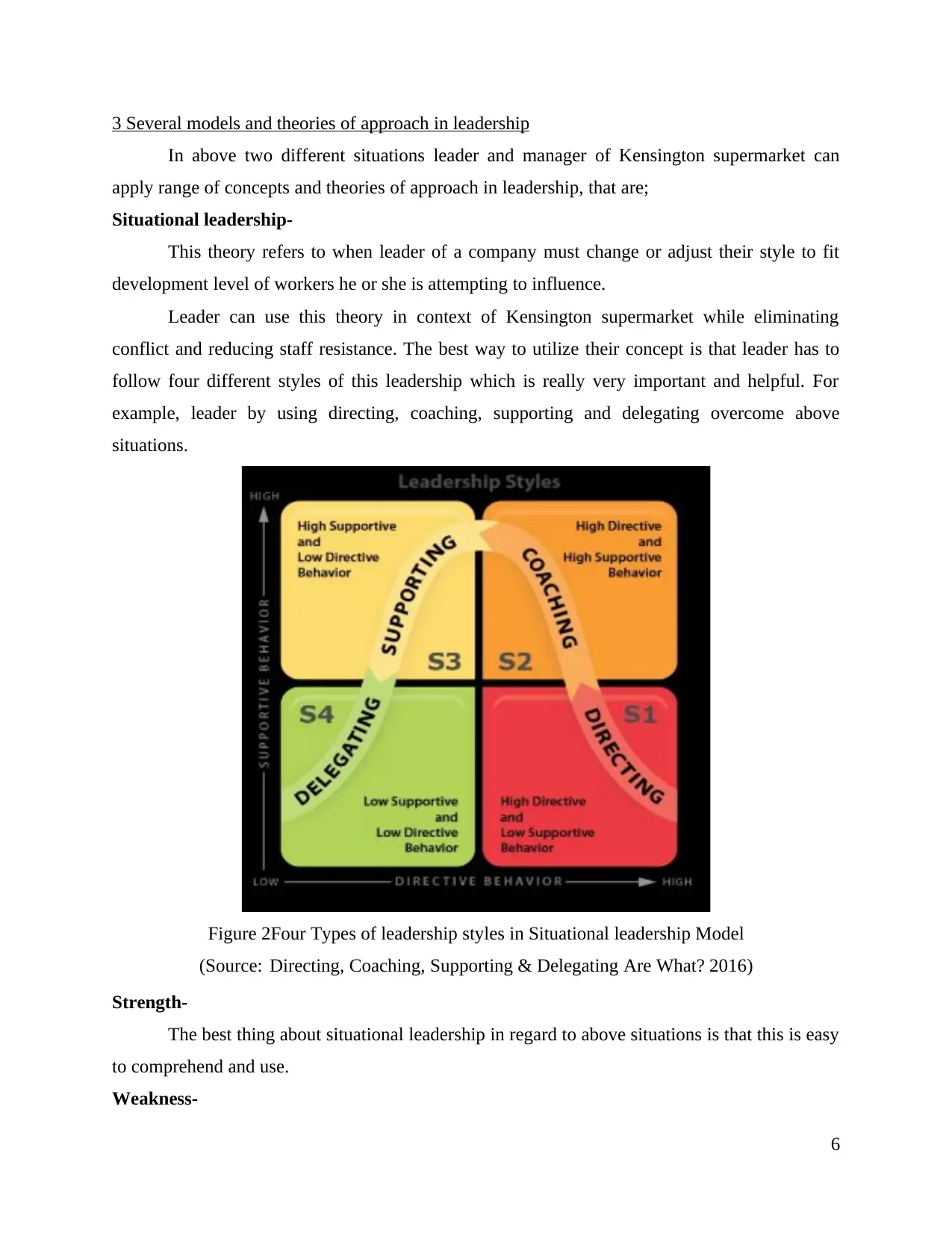
3 Several models and theories of approach in leadership
In above two different situations leader and manager of Kensington supermarket can
apply range of concepts and theories of approach in leadership, that are;
Situational leadership-
This theory refers to when leader of a company must change or adjust their style to fit
development level of workers he or she is attempting to influence.
Leader can use this theory in context of Kensington supermarket while eliminating
conflict and reducing staff resistance. The best way to utilize their concept is that leader has to
follow four different styles of this leadership which is really very important and helpful. For
example, leader by using directing, coaching, supporting and delegating overcome above
situations.
Figure 2Four Types of leadership styles in Situational leadership Model
(Source: Directing, Coaching, Supporting & Delegating Are What? 2016)
Strength-
The best thing about situational leadership in regard to above situations is that this is easy
to comprehend and use.
Weakness-
6
In above two different situations leader and manager of Kensington supermarket can
apply range of concepts and theories of approach in leadership, that are;
Situational leadership-
This theory refers to when leader of a company must change or adjust their style to fit
development level of workers he or she is attempting to influence.
Leader can use this theory in context of Kensington supermarket while eliminating
conflict and reducing staff resistance. The best way to utilize their concept is that leader has to
follow four different styles of this leadership which is really very important and helpful. For
example, leader by using directing, coaching, supporting and delegating overcome above
situations.
Figure 2Four Types of leadership styles in Situational leadership Model
(Source: Directing, Coaching, Supporting & Delegating Are What? 2016)
Strength-
The best thing about situational leadership in regard to above situations is that this is easy
to comprehend and use.
Weakness-
6
⊘ This is a preview!⊘
Do you want full access?
Subscribe today to unlock all pages.

Trusted by 1+ million students worldwide
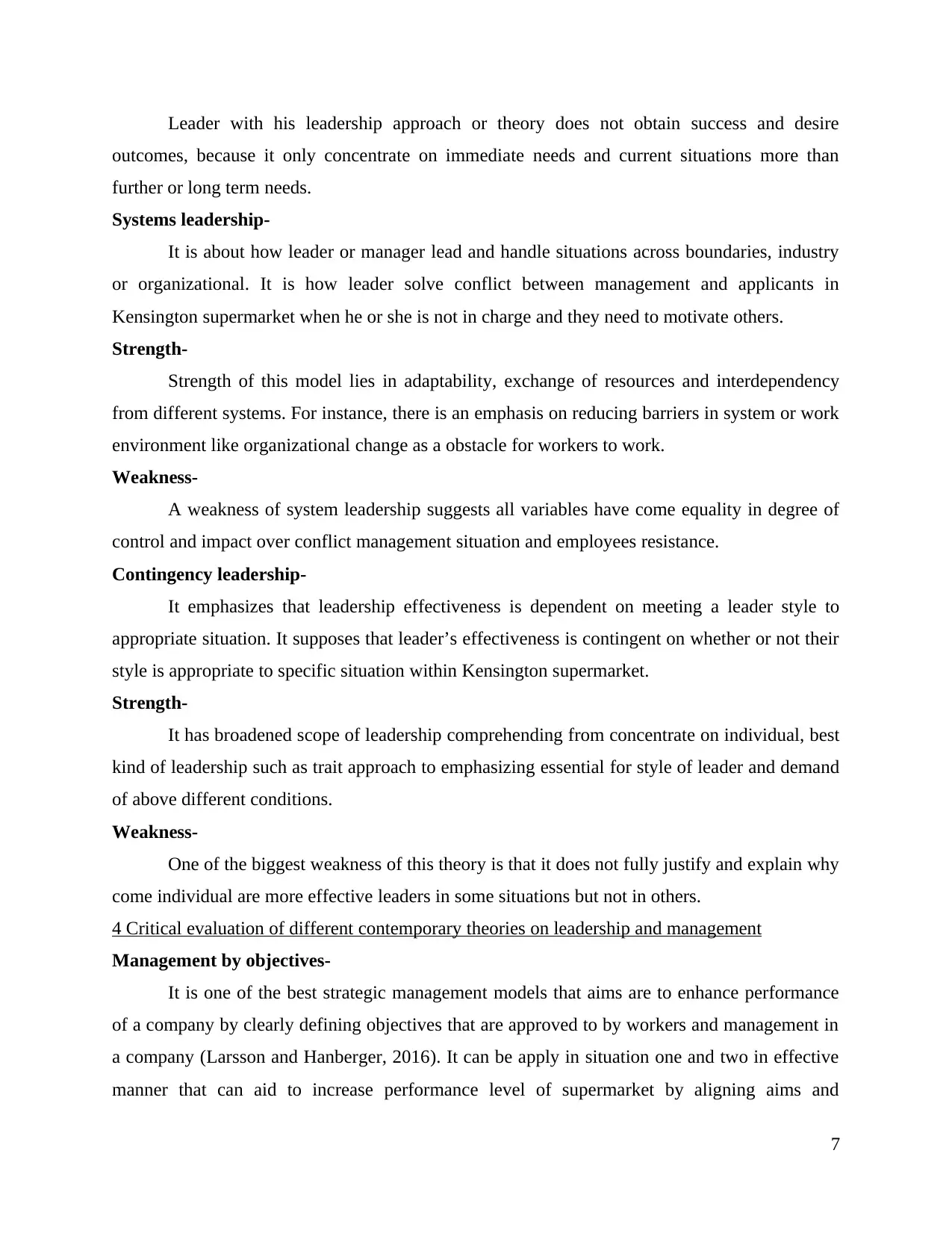
Leader with his leadership approach or theory does not obtain success and desire
outcomes, because it only concentrate on immediate needs and current situations more than
further or long term needs.
Systems leadership-
It is about how leader or manager lead and handle situations across boundaries, industry
or organizational. It is how leader solve conflict between management and applicants in
Kensington supermarket when he or she is not in charge and they need to motivate others.
Strength-
Strength of this model lies in adaptability, exchange of resources and interdependency
from different systems. For instance, there is an emphasis on reducing barriers in system or work
environment like organizational change as a obstacle for workers to work.
Weakness-
A weakness of system leadership suggests all variables have come equality in degree of
control and impact over conflict management situation and employees resistance.
Contingency leadership-
It emphasizes that leadership effectiveness is dependent on meeting a leader style to
appropriate situation. It supposes that leader’s effectiveness is contingent on whether or not their
style is appropriate to specific situation within Kensington supermarket.
Strength-
It has broadened scope of leadership comprehending from concentrate on individual, best
kind of leadership such as trait approach to emphasizing essential for style of leader and demand
of above different conditions.
Weakness-
One of the biggest weakness of this theory is that it does not fully justify and explain why
come individual are more effective leaders in some situations but not in others.
4 Critical evaluation of different contemporary theories on leadership and management
Management by objectives-
It is one of the best strategic management models that aims are to enhance performance
of a company by clearly defining objectives that are approved to by workers and management in
a company (Larsson and Hanberger, 2016). It can be apply in situation one and two in effective
manner that can aid to increase performance level of supermarket by aligning aims and
7
outcomes, because it only concentrate on immediate needs and current situations more than
further or long term needs.
Systems leadership-
It is about how leader or manager lead and handle situations across boundaries, industry
or organizational. It is how leader solve conflict between management and applicants in
Kensington supermarket when he or she is not in charge and they need to motivate others.
Strength-
Strength of this model lies in adaptability, exchange of resources and interdependency
from different systems. For instance, there is an emphasis on reducing barriers in system or work
environment like organizational change as a obstacle for workers to work.
Weakness-
A weakness of system leadership suggests all variables have come equality in degree of
control and impact over conflict management situation and employees resistance.
Contingency leadership-
It emphasizes that leadership effectiveness is dependent on meeting a leader style to
appropriate situation. It supposes that leader’s effectiveness is contingent on whether or not their
style is appropriate to specific situation within Kensington supermarket.
Strength-
It has broadened scope of leadership comprehending from concentrate on individual, best
kind of leadership such as trait approach to emphasizing essential for style of leader and demand
of above different conditions.
Weakness-
One of the biggest weakness of this theory is that it does not fully justify and explain why
come individual are more effective leaders in some situations but not in others.
4 Critical evaluation of different contemporary theories on leadership and management
Management by objectives-
It is one of the best strategic management models that aims are to enhance performance
of a company by clearly defining objectives that are approved to by workers and management in
a company (Larsson and Hanberger, 2016). It can be apply in situation one and two in effective
manner that can aid to increase performance level of supermarket by aligning aims and
7
Paraphrase This Document
Need a fresh take? Get an instant paraphrase of this document with our AI Paraphraser
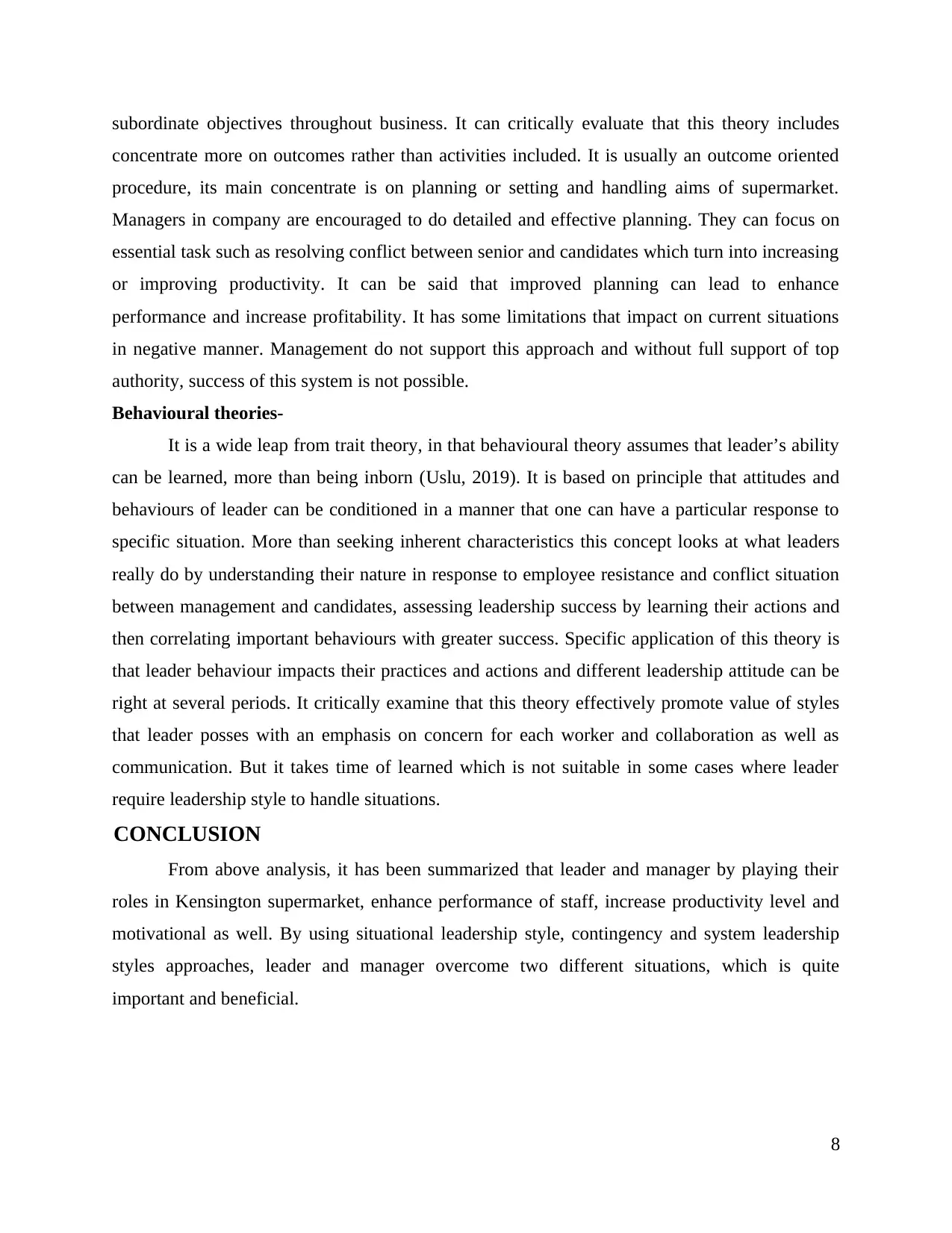
subordinate objectives throughout business. It can critically evaluate that this theory includes
concentrate more on outcomes rather than activities included. It is usually an outcome oriented
procedure, its main concentrate is on planning or setting and handling aims of supermarket.
Managers in company are encouraged to do detailed and effective planning. They can focus on
essential task such as resolving conflict between senior and candidates which turn into increasing
or improving productivity. It can be said that improved planning can lead to enhance
performance and increase profitability. It has some limitations that impact on current situations
in negative manner. Management do not support this approach and without full support of top
authority, success of this system is not possible.
Behavioural theories-
It is a wide leap from trait theory, in that behavioural theory assumes that leader’s ability
can be learned, more than being inborn (Uslu, 2019). It is based on principle that attitudes and
behaviours of leader can be conditioned in a manner that one can have a particular response to
specific situation. More than seeking inherent characteristics this concept looks at what leaders
really do by understanding their nature in response to employee resistance and conflict situation
between management and candidates, assessing leadership success by learning their actions and
then correlating important behaviours with greater success. Specific application of this theory is
that leader behaviour impacts their practices and actions and different leadership attitude can be
right at several periods. It critically examine that this theory effectively promote value of styles
that leader posses with an emphasis on concern for each worker and collaboration as well as
communication. But it takes time of learned which is not suitable in some cases where leader
require leadership style to handle situations.
CONCLUSION
From above analysis, it has been summarized that leader and manager by playing their
roles in Kensington supermarket, enhance performance of staff, increase productivity level and
motivational as well. By using situational leadership style, contingency and system leadership
styles approaches, leader and manager overcome two different situations, which is quite
important and beneficial.
8
concentrate more on outcomes rather than activities included. It is usually an outcome oriented
procedure, its main concentrate is on planning or setting and handling aims of supermarket.
Managers in company are encouraged to do detailed and effective planning. They can focus on
essential task such as resolving conflict between senior and candidates which turn into increasing
or improving productivity. It can be said that improved planning can lead to enhance
performance and increase profitability. It has some limitations that impact on current situations
in negative manner. Management do not support this approach and without full support of top
authority, success of this system is not possible.
Behavioural theories-
It is a wide leap from trait theory, in that behavioural theory assumes that leader’s ability
can be learned, more than being inborn (Uslu, 2019). It is based on principle that attitudes and
behaviours of leader can be conditioned in a manner that one can have a particular response to
specific situation. More than seeking inherent characteristics this concept looks at what leaders
really do by understanding their nature in response to employee resistance and conflict situation
between management and candidates, assessing leadership success by learning their actions and
then correlating important behaviours with greater success. Specific application of this theory is
that leader behaviour impacts their practices and actions and different leadership attitude can be
right at several periods. It critically examine that this theory effectively promote value of styles
that leader posses with an emphasis on concern for each worker and collaboration as well as
communication. But it takes time of learned which is not suitable in some cases where leader
require leadership style to handle situations.
CONCLUSION
From above analysis, it has been summarized that leader and manager by playing their
roles in Kensington supermarket, enhance performance of staff, increase productivity level and
motivational as well. By using situational leadership style, contingency and system leadership
styles approaches, leader and manager overcome two different situations, which is quite
important and beneficial.
8
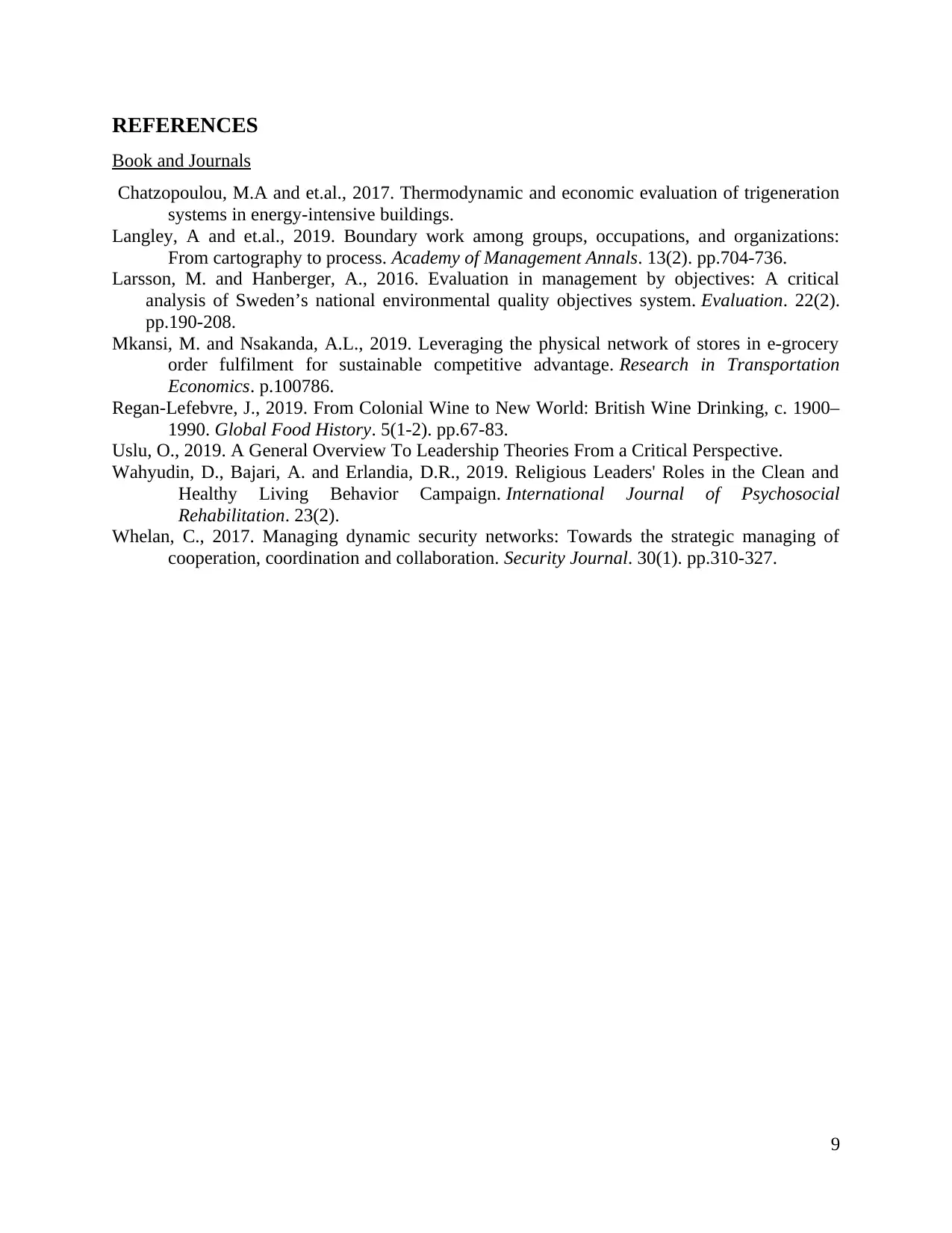
REFERENCES
Book and Journals
Chatzopoulou, M.A and et.al., 2017. Thermodynamic and economic evaluation of trigeneration
systems in energy-intensive buildings.
Langley, A and et.al., 2019. Boundary work among groups, occupations, and organizations:
From cartography to process. Academy of Management Annals. 13(2). pp.704-736.
Larsson, M. and Hanberger, A., 2016. Evaluation in management by objectives: A critical
analysis of Sweden’s national environmental quality objectives system. Evaluation. 22(2).
pp.190-208.
Mkansi, M. and Nsakanda, A.L., 2019. Leveraging the physical network of stores in e-grocery
order fulfilment for sustainable competitive advantage. Research in Transportation
Economics. p.100786.
Regan-Lefebvre, J., 2019. From Colonial Wine to New World: British Wine Drinking, c. 1900–
1990. Global Food History. 5(1-2). pp.67-83.
Uslu, O., 2019. A General Overview To Leadership Theories From a Critical Perspective.
Wahyudin, D., Bajari, A. and Erlandia, D.R., 2019. Religious Leaders' Roles in the Clean and
Healthy Living Behavior Campaign. International Journal of Psychosocial
Rehabilitation. 23(2).
Whelan, C., 2017. Managing dynamic security networks: Towards the strategic managing of
cooperation, coordination and collaboration. Security Journal. 30(1). pp.310-327.
9
Book and Journals
Chatzopoulou, M.A and et.al., 2017. Thermodynamic and economic evaluation of trigeneration
systems in energy-intensive buildings.
Langley, A and et.al., 2019. Boundary work among groups, occupations, and organizations:
From cartography to process. Academy of Management Annals. 13(2). pp.704-736.
Larsson, M. and Hanberger, A., 2016. Evaluation in management by objectives: A critical
analysis of Sweden’s national environmental quality objectives system. Evaluation. 22(2).
pp.190-208.
Mkansi, M. and Nsakanda, A.L., 2019. Leveraging the physical network of stores in e-grocery
order fulfilment for sustainable competitive advantage. Research in Transportation
Economics. p.100786.
Regan-Lefebvre, J., 2019. From Colonial Wine to New World: British Wine Drinking, c. 1900–
1990. Global Food History. 5(1-2). pp.67-83.
Uslu, O., 2019. A General Overview To Leadership Theories From a Critical Perspective.
Wahyudin, D., Bajari, A. and Erlandia, D.R., 2019. Religious Leaders' Roles in the Clean and
Healthy Living Behavior Campaign. International Journal of Psychosocial
Rehabilitation. 23(2).
Whelan, C., 2017. Managing dynamic security networks: Towards the strategic managing of
cooperation, coordination and collaboration. Security Journal. 30(1). pp.310-327.
9
⊘ This is a preview!⊘
Do you want full access?
Subscribe today to unlock all pages.

Trusted by 1+ million students worldwide
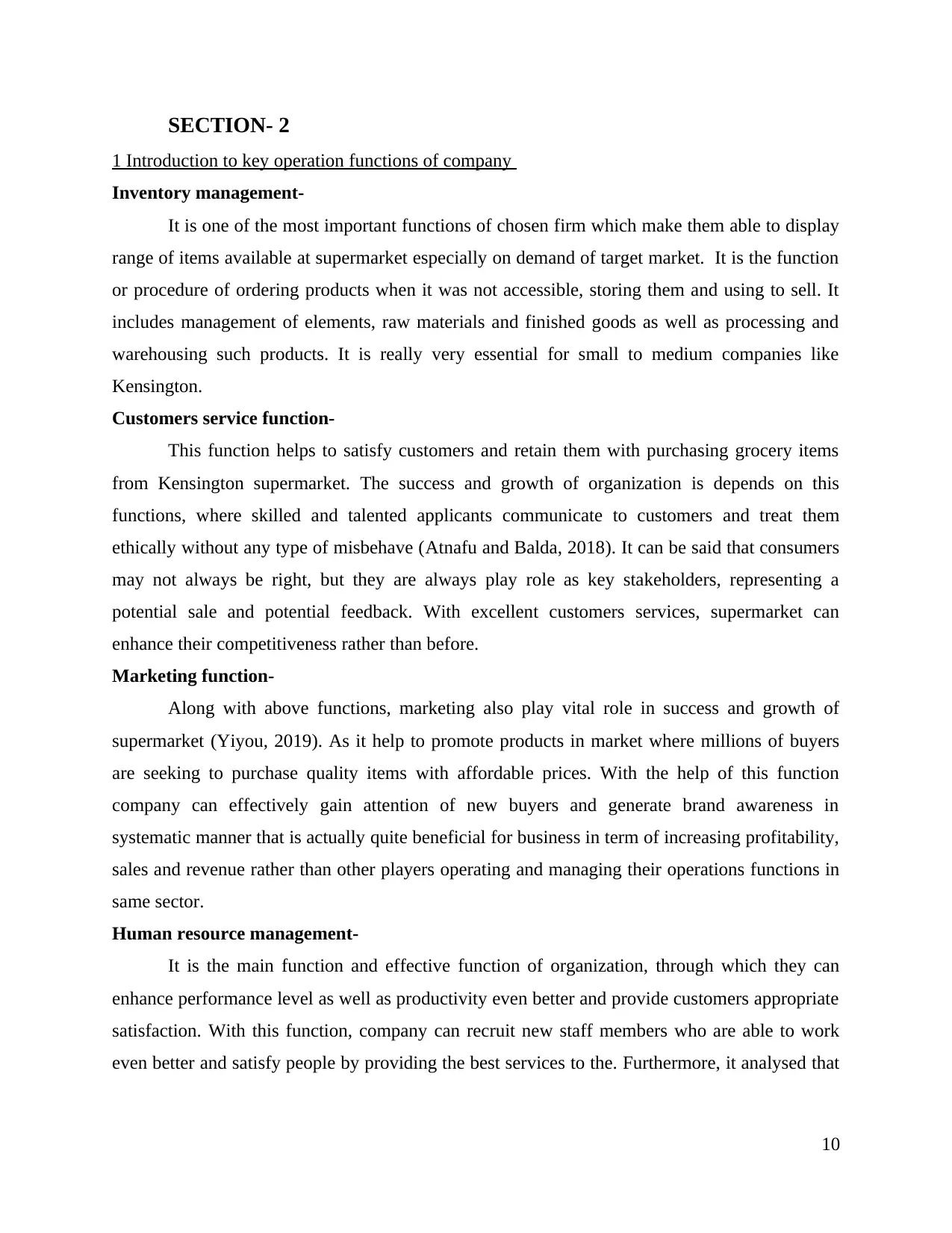
SECTION- 2
1 Introduction to key operation functions of company
Inventory management-
It is one of the most important functions of chosen firm which make them able to display
range of items available at supermarket especially on demand of target market. It is the function
or procedure of ordering products when it was not accessible, storing them and using to sell. It
includes management of elements, raw materials and finished goods as well as processing and
warehousing such products. It is really very essential for small to medium companies like
Kensington.
Customers service function-
This function helps to satisfy customers and retain them with purchasing grocery items
from Kensington supermarket. The success and growth of organization is depends on this
functions, where skilled and talented applicants communicate to customers and treat them
ethically without any type of misbehave (Atnafu and Balda, 2018). It can be said that consumers
may not always be right, but they are always play role as key stakeholders, representing a
potential sale and potential feedback. With excellent customers services, supermarket can
enhance their competitiveness rather than before.
Marketing function-
Along with above functions, marketing also play vital role in success and growth of
supermarket (Yiyou, 2019). As it help to promote products in market where millions of buyers
are seeking to purchase quality items with affordable prices. With the help of this function
company can effectively gain attention of new buyers and generate brand awareness in
systematic manner that is actually quite beneficial for business in term of increasing profitability,
sales and revenue rather than other players operating and managing their operations functions in
same sector.
Human resource management-
It is the main function and effective function of organization, through which they can
enhance performance level as well as productivity even better and provide customers appropriate
satisfaction. With this function, company can recruit new staff members who are able to work
even better and satisfy people by providing the best services to the. Furthermore, it analysed that
10
1 Introduction to key operation functions of company
Inventory management-
It is one of the most important functions of chosen firm which make them able to display
range of items available at supermarket especially on demand of target market. It is the function
or procedure of ordering products when it was not accessible, storing them and using to sell. It
includes management of elements, raw materials and finished goods as well as processing and
warehousing such products. It is really very essential for small to medium companies like
Kensington.
Customers service function-
This function helps to satisfy customers and retain them with purchasing grocery items
from Kensington supermarket. The success and growth of organization is depends on this
functions, where skilled and talented applicants communicate to customers and treat them
ethically without any type of misbehave (Atnafu and Balda, 2018). It can be said that consumers
may not always be right, but they are always play role as key stakeholders, representing a
potential sale and potential feedback. With excellent customers services, supermarket can
enhance their competitiveness rather than before.
Marketing function-
Along with above functions, marketing also play vital role in success and growth of
supermarket (Yiyou, 2019). As it help to promote products in market where millions of buyers
are seeking to purchase quality items with affordable prices. With the help of this function
company can effectively gain attention of new buyers and generate brand awareness in
systematic manner that is actually quite beneficial for business in term of increasing profitability,
sales and revenue rather than other players operating and managing their operations functions in
same sector.
Human resource management-
It is the main function and effective function of organization, through which they can
enhance performance level as well as productivity even better and provide customers appropriate
satisfaction. With this function, company can recruit new staff members who are able to work
even better and satisfy people by providing the best services to the. Furthermore, it analysed that
10
Paraphrase This Document
Need a fresh take? Get an instant paraphrase of this document with our AI Paraphraser
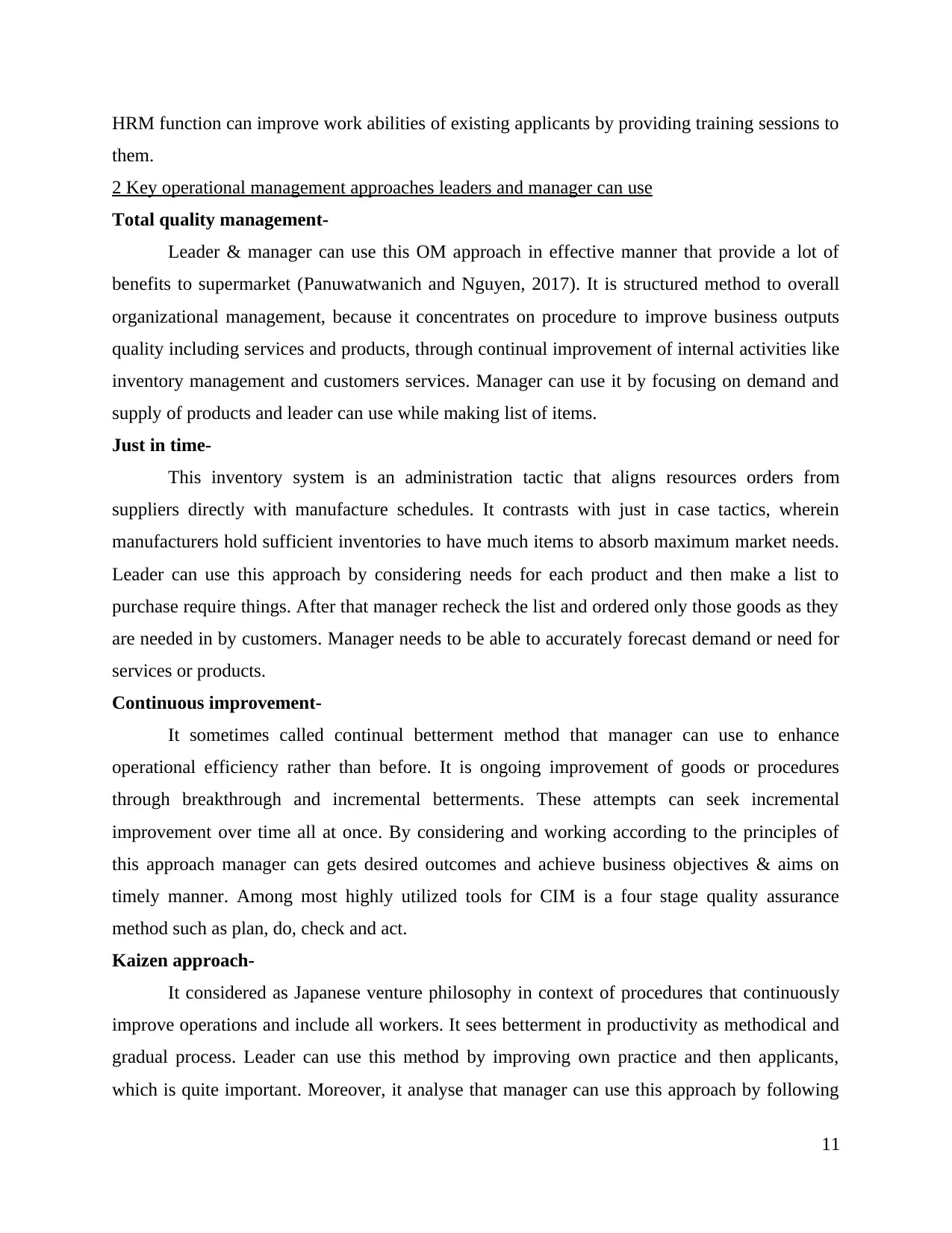
HRM function can improve work abilities of existing applicants by providing training sessions to
them.
2 Key operational management approaches leaders and manager can use
Total quality management-
Leader & manager can use this OM approach in effective manner that provide a lot of
benefits to supermarket (Panuwatwanich and Nguyen, 2017). It is structured method to overall
organizational management, because it concentrates on procedure to improve business outputs
quality including services and products, through continual improvement of internal activities like
inventory management and customers services. Manager can use it by focusing on demand and
supply of products and leader can use while making list of items.
Just in time-
This inventory system is an administration tactic that aligns resources orders from
suppliers directly with manufacture schedules. It contrasts with just in case tactics, wherein
manufacturers hold sufficient inventories to have much items to absorb maximum market needs.
Leader can use this approach by considering needs for each product and then make a list to
purchase require things. After that manager recheck the list and ordered only those goods as they
are needed in by customers. Manager needs to be able to accurately forecast demand or need for
services or products.
Continuous improvement-
It sometimes called continual betterment method that manager can use to enhance
operational efficiency rather than before. It is ongoing improvement of goods or procedures
through breakthrough and incremental betterments. These attempts can seek incremental
improvement over time all at once. By considering and working according to the principles of
this approach manager can gets desired outcomes and achieve business objectives & aims on
timely manner. Among most highly utilized tools for CIM is a four stage quality assurance
method such as plan, do, check and act.
Kaizen approach-
It considered as Japanese venture philosophy in context of procedures that continuously
improve operations and include all workers. It sees betterment in productivity as methodical and
gradual process. Leader can use this method by improving own practice and then applicants,
which is quite important. Moreover, it analyse that manager can use this approach by following
11
them.
2 Key operational management approaches leaders and manager can use
Total quality management-
Leader & manager can use this OM approach in effective manner that provide a lot of
benefits to supermarket (Panuwatwanich and Nguyen, 2017). It is structured method to overall
organizational management, because it concentrates on procedure to improve business outputs
quality including services and products, through continual improvement of internal activities like
inventory management and customers services. Manager can use it by focusing on demand and
supply of products and leader can use while making list of items.
Just in time-
This inventory system is an administration tactic that aligns resources orders from
suppliers directly with manufacture schedules. It contrasts with just in case tactics, wherein
manufacturers hold sufficient inventories to have much items to absorb maximum market needs.
Leader can use this approach by considering needs for each product and then make a list to
purchase require things. After that manager recheck the list and ordered only those goods as they
are needed in by customers. Manager needs to be able to accurately forecast demand or need for
services or products.
Continuous improvement-
It sometimes called continual betterment method that manager can use to enhance
operational efficiency rather than before. It is ongoing improvement of goods or procedures
through breakthrough and incremental betterments. These attempts can seek incremental
improvement over time all at once. By considering and working according to the principles of
this approach manager can gets desired outcomes and achieve business objectives & aims on
timely manner. Among most highly utilized tools for CIM is a four stage quality assurance
method such as plan, do, check and act.
Kaizen approach-
It considered as Japanese venture philosophy in context of procedures that continuously
improve operations and include all workers. It sees betterment in productivity as methodical and
gradual process. Leader can use this method by improving own practice and then applicants,
which is quite important. Moreover, it analyse that manager can use this approach by following
11
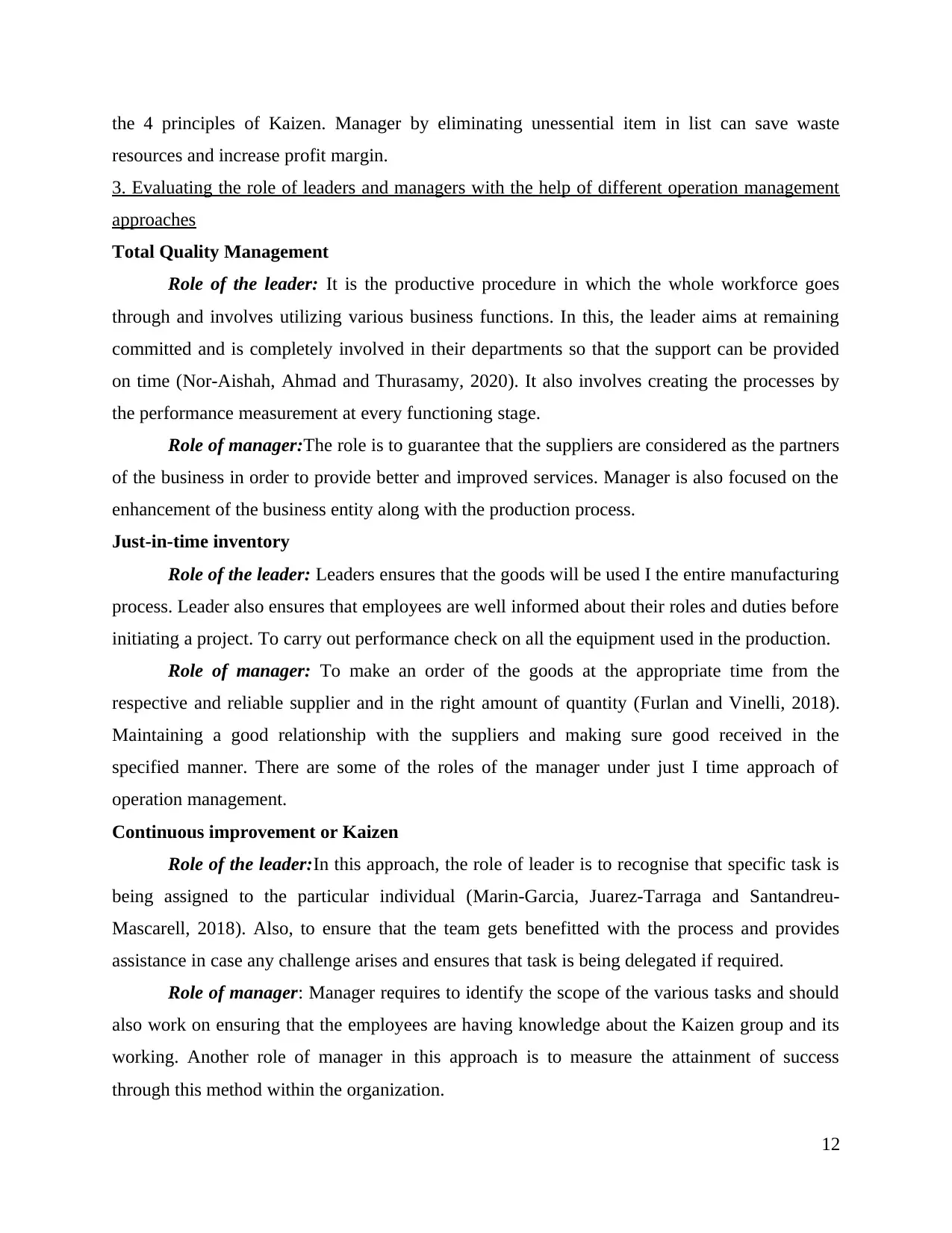
the 4 principles of Kaizen. Manager by eliminating unessential item in list can save waste
resources and increase profit margin.
3. Evaluating the role of leaders and managers with the help of different operation management
approaches
Total Quality Management
Role of the leader: It is the productive procedure in which the whole workforce goes
through and involves utilizing various business functions. In this, the leader aims at remaining
committed and is completely involved in their departments so that the support can be provided
on time (Nor-Aishah, Ahmad and Thurasamy, 2020). It also involves creating the processes by
the performance measurement at every functioning stage.
Role of manager:The role is to guarantee that the suppliers are considered as the partners
of the business in order to provide better and improved services. Manager is also focused on the
enhancement of the business entity along with the production process.
Just-in-time inventory
Role of the leader: Leaders ensures that the goods will be used I the entire manufacturing
process. Leader also ensures that employees are well informed about their roles and duties before
initiating a project. To carry out performance check on all the equipment used in the production.
Role of manager: To make an order of the goods at the appropriate time from the
respective and reliable supplier and in the right amount of quantity (Furlan and Vinelli, 2018).
Maintaining a good relationship with the suppliers and making sure good received in the
specified manner. There are some of the roles of the manager under just I time approach of
operation management.
Continuous improvement or Kaizen
Role of the leader:In this approach, the role of leader is to recognise that specific task is
being assigned to the particular individual (Marin-Garcia, Juarez-Tarraga and Santandreu-
Mascarell, 2018). Also, to ensure that the team gets benefitted with the process and provides
assistance in case any challenge arises and ensures that task is being delegated if required.
Role of manager: Manager requires to identify the scope of the various tasks and should
also work on ensuring that the employees are having knowledge about the Kaizen group and its
working. Another role of manager in this approach is to measure the attainment of success
through this method within the organization.
12
resources and increase profit margin.
3. Evaluating the role of leaders and managers with the help of different operation management
approaches
Total Quality Management
Role of the leader: It is the productive procedure in which the whole workforce goes
through and involves utilizing various business functions. In this, the leader aims at remaining
committed and is completely involved in their departments so that the support can be provided
on time (Nor-Aishah, Ahmad and Thurasamy, 2020). It also involves creating the processes by
the performance measurement at every functioning stage.
Role of manager:The role is to guarantee that the suppliers are considered as the partners
of the business in order to provide better and improved services. Manager is also focused on the
enhancement of the business entity along with the production process.
Just-in-time inventory
Role of the leader: Leaders ensures that the goods will be used I the entire manufacturing
process. Leader also ensures that employees are well informed about their roles and duties before
initiating a project. To carry out performance check on all the equipment used in the production.
Role of manager: To make an order of the goods at the appropriate time from the
respective and reliable supplier and in the right amount of quantity (Furlan and Vinelli, 2018).
Maintaining a good relationship with the suppliers and making sure good received in the
specified manner. There are some of the roles of the manager under just I time approach of
operation management.
Continuous improvement or Kaizen
Role of the leader:In this approach, the role of leader is to recognise that specific task is
being assigned to the particular individual (Marin-Garcia, Juarez-Tarraga and Santandreu-
Mascarell, 2018). Also, to ensure that the team gets benefitted with the process and provides
assistance in case any challenge arises and ensures that task is being delegated if required.
Role of manager: Manager requires to identify the scope of the various tasks and should
also work on ensuring that the employees are having knowledge about the Kaizen group and its
working. Another role of manager in this approach is to measure the attainment of success
through this method within the organization.
12
⊘ This is a preview!⊘
Do you want full access?
Subscribe today to unlock all pages.

Trusted by 1+ million students worldwide
1 out of 17
Related Documents
Your All-in-One AI-Powered Toolkit for Academic Success.
+13062052269
info@desklib.com
Available 24*7 on WhatsApp / Email
![[object Object]](/_next/static/media/star-bottom.7253800d.svg)
Unlock your academic potential
Copyright © 2020–2025 A2Z Services. All Rights Reserved. Developed and managed by ZUCOL.





